CHAPTER FIVE
![]()
THE
NEW
AGE
OF
ACCESS
![]()
How to capitalise on e-commerce
without losing intimacy
in an era of digital transparency
RETHINKING LUXURY
“The Internet changed everything,”
said designer Dries Van Noten
after a recent fashion show in Paris.
“When you’re putting together a
fashion show now, you have
to ask yourself, what will be the first
image that people see online?
Will the print on the clothes be big
enough to see on an iPhone?”
It is a remarkably candid statement,
considering that designers
traditionally want full creative control
of their shows. Says Van Noten,
“In the past, the professional press
wrote the reviews. Then 13- or
14-year-old girls started writing
reviews. You can say that’s wrong.
But it’s modern times.”
Dries Van Noten’s open-mindedness here could be rooted in his background as part of the “The Antwerp Six”, an avant-garde group of Belgian designers who rose to prominence in the 1980s. They rejected accepted conventions of fashion and marketing. Or perhaps Van Noten is just very clued in to the digital age. Either way, he broached a subject with which many of his fellow designers are struggling to come to terms. Success as a luxury brand no longer depends on pleasing the old guard of money or the professionals judging the collections with trained eyes. The Internet has made luxury consumption more transparent. Today, a company has to reach the future, Internet-savvy generation of shoppers, directly and unfiltered. For example, not many 14-year-old girls in the world can spend €1,500 on a silk-embroidered coat by Dries Van Noten. But they might one day. And until that day comes, their aspirations are part of the conversation about luxury. These are some of the gatekeepers that luxury brands must acknowledge today.
AN OPEN CONVERSATION
Until recently, that conversation was more a private matter. There was a silent understanding between the manufacturers and the buyers, who expressed their appreciation not so much in words as in an exchange of money. If discussions took place, they would be discreet, almost intimate. Think of the tailor on Savile Row measuring a customer, the luxury watchmaker inviting a client to the workshop in Glashütte, the designer making alterations for a woman ordering a couture dress. The once highly personal nature of luxury chit-chat is being drowned out by the clamour of the Internet. And the noise is only getting louder. Global online sales of luxury goods are outperforming the rest of the market in terms of growth. As this progresses, we believe it is vital for brands to make themselves heard. There is money to be made online. The emergence of the Internet has been noticed by the industry. Many companies have understood that they must transfer the luxury experience from the real world to the digital universe. But they are still unsure of how to capitalise on e-commerce without losing the intimacy that once was a hallmark of luxury. The Internet is a great equaliser. Everyone has access. Someone who might not visit a boutique in St. Moritz is two mouse clicks away from looking at the brand’s online shop. For a market that is based on exclusivity, democratisation presents a challenge. How do you increase revenue while maintaining a brand’s image? The first step is to reach a better understanding of your customers.
For one thing, luxury customers are getting younger. Generation X and Y shoppers, especially in Western countries, are single-person households until much later in life than were their parents. They have only their own wishes and desires to consider when they are spending. Research indicates that they are also more likely than their parents to have been exposed to luxury early in their lives. What they have in common with their predecessors, however, is that they expect their time and money to be valued by the brands they invest in. As we pointed out in chapter four, the post-recession consumer, especially in established economies, is looking for luxury that expresses sophistication. They desire something that is not for everyone.
Keeping these demographic changes in mind, we believe that brands must also consider a second development shaping the market: the near ubiquity of personal computers, tablets and smartphones among luxury consumers. They were able to afford the devices before anyone else, and have consequently moulded their lives around them. Research among affluent consumers in the United States has shown that 98 per cent of them shop online already, spending five hours per week on e-commerce websites and on average $3,700 every three months on orders. Interestingly, nearly half of those consumers use mobile devices to shop online, and the highest percentage of these are consumers under the age of 45. This development is likely to spread to emerging economies, as the global market for smartphones is rapidly growing. Some 2.4 billion PCs, laptops, tablets and smartphones were sold worldwide in 2013 and, by 2016, tablets and smartphones will outsell PCs and laptops. Being online will be part of everyone’s reality, not just current luxury shoppers. To appeal to an Internet-savvy luxury consumer, brands will have to offer more than a directory of online shops on their websites with the hope that visitors will navigate their own way to the products. Instead, companies should start viewing the Internet as something that can add to the experience of buying luxury rather than something that will diminish the brand. They should keep in mind that the majority of people who regularly buy luxury goods online stay loyal to their preferred brands on the Internet.
Certainly, online cannot offer everything available in a boutique. The grandeur of a shop’s interior, the handle of an expensive fabric, the gleam of a gemstone – these qualities are impossible to duplicate. In chapter six, we will look further into the power of walk-in shops. But luxury has always also stood for innovation – a word that immediately comes to mind when thinking about digital lifestlyes.
TIME FOR CHANGE
Considering the old world aura of Swiss watch brands, it is perhaps surprising that they were some of the first luxury products to go online. For our case study on pages 114 and 115, we selected some of the most convincing technological novelties by watchmakers. For now, we want to focus on one specific example. Vacheron Constantin, a famous name from the world of haute horlogerie, offers customers access to The Hour Lounge, a digital forum where enthusiasts can share their love and knowledge of fine watchmaking. The Hour Lounge delivers something that luxury consumers treasure: the feeling of being knowledgeable and informed. It also is a convenient way to attract customers who want access to this exclusive world. The forum grants that wish, and at the same time acknowledges the brand loyalty of existing customers. The success of an experiment like this remains to be seen.
We believe that appealing to the gatekeepers, those consumers who get first access and then spread the word, is a smart way for brands to be part of the conversation, but also to dominate the way in which the brand is discussed. Research suggests that wealthy shoppers almost uniformly agree that buying online does not devalue the luxury experience. Many of them would like their favourite luxury brands to have an excellent online presence. Another study found that close to three-quarters of luxury product consumers do not set a limit to how much they will spend on online purchases. For these consumers, time really is money. The more convenient it is for them to access their favourite brands online, the more likely they are to spread their wealth.
INFLUENCERS
Luxury watch companies are leading the way in digital innovation with smart-looking apps
In the luxury sector, watchmakers were among the first to embrace apps for their customers. Perhaps it was because of their historic interest in innovation. But they haven’t taken long to get it right. Not long ago it was as if a different watchmaker was unveiling a new app every week. And the apps themselves were often unique, going beyond mirroring what was already available in print or online. Watch app fever eventually spread beyond manufacturers to watch publications and enthusiasts. Regardless of whether the app originates with a manufacturer or an aficionado, they are all good for the watch industry.
Jaeger-LeCoultre
Creating an app can be simple. It has become a rite of passage for first-year computer students. However, developing a useful, innovative app requires commitment, imagination and courage. Jaeger-LeCoultre set the bar high with one of the first watch apps in 2009. Taking advantage of the format’s multimedia capabilities, the company offered a digital version of its current catalogue and also provided six brief tutorials in watchmaking. The tutorials had little value beyond their first viewing, but they offered fans and owners something new and created a buzz for the brand.
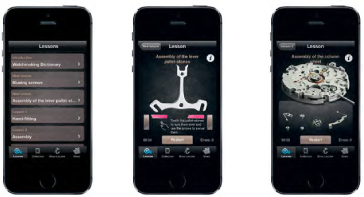
Effective apps like the one from Jaeger-LeCoultre must offer something more than a digital version of a brand’s portfolio.
Girard-Perregaux
Good apps must offer something other than a digital version of a brand’s portfolio. When they do, they not only attract the attention of loyal followers, but also act as brand ambassadors. Girard-Perregaux added a new twist to the watch app mix. You can take a picture of your wrist, and let the app enhance it with an actual Girard-Perregaux model of your choice. Neither this nor the Jaeger-LeCoultre app seems particularly modern or revolutionary, but both are a step in the right direction. They use innovation to move app technology forward and get the word out about their exceptional brand. They do not settle for a simple app reflecting marketing material that can be found elsewhere. They create something different.
Linde Werdelin
Finally, Linde Werdelin went somewhere completely different. It offers its fans a ski-guide app that taps into GPS information to help users find restaurants, slopes and hotels. The app is special because it gets the brand’s message into a space one would not expect to find it. Customers think of their watches while trying to find the best place to ski.
THE CUSTOMER ADVANTAGE
Showcasing the uniqueness of a product online is an important selling point. But another vital aspect of shifting luxury goods online is providing an excellent selection. Fashion and footwear have the highest presence of any luxury goods sector online. Given these overwhelming numbers, we want to highlight one of the Internet’s success stories. Net-A-Porter, the multi-brand online store for luxury women’s clothing and accessories, was founded by entrepreneur Natalie Massenet in 2000 and has since been acquired by Richemont. The company has demonstrated acumen in addressing two questions that determine the success of any luxury brand online. First, what is the customer’s advantage in buying from us? And then, how do we gain their trust? Faith in a brand’s image is a characteristic of luxury products. Net-A-Porter’s unrivaled selection covers over 400 brands, from Alaïa to Yves Saint Laurent, and it often introduces its customers to new labels. In doing so, it provides a range of products that the customer would otherwise never encounter in one shop.
The basics of Net-A-Porter’s service are an easy payment process and express deliveries. There is a stylist on hand to help with selections, and the customer receives a personalised note with each purchase. Customised email messages inform the shopper when new stock of their preferred brands have arrived at the warehouse. From the start, Net-A-Porter also introduced collaborations with designers such as Stella McCartney and Alexander McQueen, giving its customers priority access to sought-after goods. Rounding off the Net-A-Porter world is its own online magazine and a big presence on social media sites. For Net-A-Porter, engaging the consumer on many levels while making things easy has been rewarded with great loyalty. The site gets around six million visitors every month. It is very different to the impersonal world the Internet is sometimes made out to be. Being able to compare brands through technology gives consumers an outlet for their curiosity about fashion trends. Even for those consumers who just drop into the site without buying, having this access is an aspirational experience, and one with which they can actually interact. This interaction can enhance the latent appeal of products.
Luxury consumers use the Internet to compare prices, too. The expenditure on “off-price” goods steadily increases year to year, showing that shoppers are interested in e-commerce to gain an advantage in terms of price. Getting a discount or a good deal on a product or service lets them feel like they are getting priority treatment. This is the success behind popular websites for discounted designer goods such as The Outnet, Gilt or Yoox. Brands worried that the “best deal” mentality of the Internet will affect their sales should remember that although luxury consumers are not above comparing products and prices, getting something at a discount is not their primary motivation. Here’s a case in point. On Net-A-Porter, the most expensive and exclusive items sell extremely well. Some Balmain jeans sell out almost as soon as they become available, and they cost €10,000. Those who bought them did not expect them to be cheaper just because they were being sold on an online shop.
Net-A-Porter’s business model has paved the way for others to follow. Multi-brand online shops such as Germany’s Mytheresa and Stylebop are currently reporting annual double-digit growth. Modelling an online store on other’s successes can work, but the luxury industry has always been about leading the way. Brands should view the Internet as an opportunity to explore new ideas and ventures. A good example is Moda Operandi. The e-commerce site was launched in 2011 to offer subscribers preferred access to luxury fashion directly from the runway. Registered customers pay a deposit on the goods, reserving them for later in the season. Allowing customers to come first has boosted Moda Operandi’s profile. After only its first year, the company received $36 million in funding from companies such as LVMH, IMG and Condé Nast.
REINVENTING A CLASSIC
The success of multi-brand online shops so far discussed depends on establishing good relationships with the brands. However, brands should also consider approaching their customers directly, because this increases control over the brand’s image. It sometimes offers an opportunity to redefine that image entirely. Burberry has been much praised for recognising the power of digital early on and using it to its advantage. Under the guidance of former CEO Angela Ahrendts, the brand has given itself a complete makeover.
Burberry was founded in England in 1856 and became known for inventing a new fabric for raincoats. For many years, the brand relied heavily on its famous raincoats. Too heavily. It missed developing more products, and financial problems followed. When Ahrendts took over in 2006, alongside head designer Christopher Bailey, she devised a strategy to create a modern luxury brand for a worldwide market that simultaneously honoured the brand’s British roots. The trademark check pattern was retained. Classics like the trench coat were redesigned for their high-fashion line Burberry Prorsum to appeal to younger and more style-conscious consumers. To supplement the new direction, Burberry also invested in its online presence. It was one of the first fashion houses to live-stream a catwalk show. Starting with its autumn 2010 Burberry Prorsum collection, it allowed customers to order items from the runway via an app. The purchases were then delivered before stock reached the shops. Customers were also encouraged to give feedback via the interactive website, the “Art of the Trench”, where people could upload pictures of how they wear their trench coats in their everyday lives and on special occasions. The site also featured images from blogger Scott Schuman of The Sartorialist. Burberry’s new business strategy culminated in the opening of a flagship store on Regent Street in London, reversing the common business model by transferring the online shopping experience into the real world. Salespeople carry iPads to show customers how a personalised trench coat might look on them. Customers can also order items that might not be in stock or get details on more than 8,000 items on digital displays. We think this is a strategy that needs to be investigated by any brand. We will discuss this further in chapter six.
Burberry has managed to bridge the gap between keeping an exclusive image and improving revenue, and the company’s profits have soared under Ahrendts’ leadership. Competitors are pursuing the same success. Barbara Rybka, who spent a decade in Silicon Valley before becoming Gucci’s digital director, told the magazine Fast Company, “If you look at the average luxury shopper, they consume most information through their mobile devices, even more so than the average smartphone user.” Half of Gucci.com’s traffic comes from people on smartphones, clicking through from email blasts. After the launch of a new mobile site in early 2013, Gucci’s shoppers have proven her right.
Digital presence
Burberry has created a very successful web cosmos that is seamlessly integrated into its real-world stores.
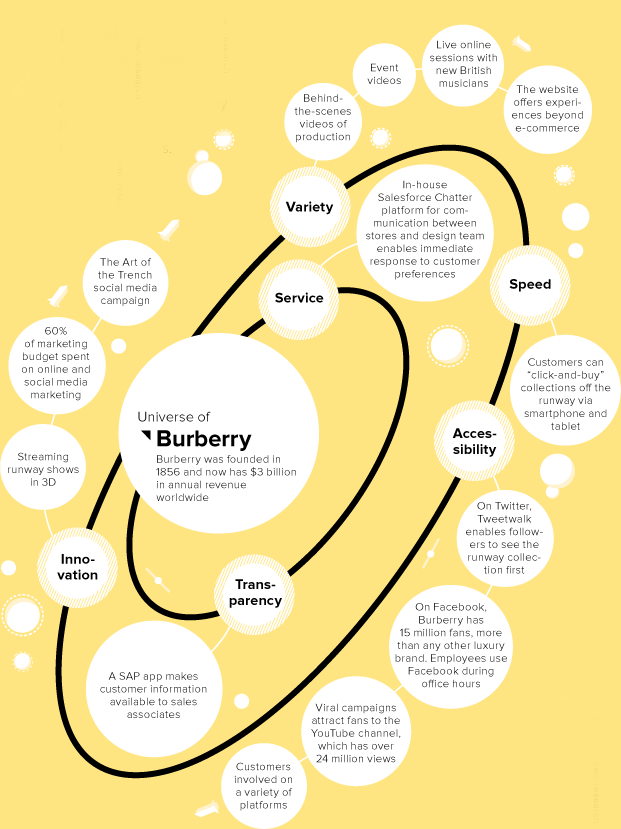
Source: Burberry, own research
The mobile future
Shopping online with mobile devices is becoming more important. By 2017, tablets will be outselling PCs, and an increasing number of consumers will be buying smartphones and ultramobile PCs.
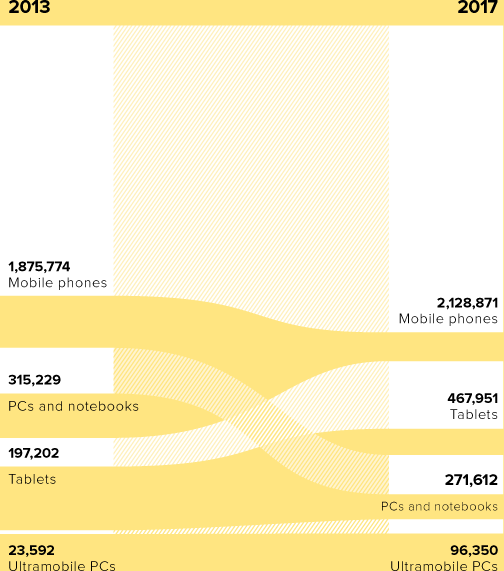
Shipments in thousands of units
Source: Gartner Market Research 2013
The site has brought in far more customers than anticipated. Their mobile conversion rates have increased by 70 per cent, and mobile revenue has quadrupled. These numbers are mainly thanks to the site’s simplification of the entire e-commerce experience, from browsing to checking out. Says Mark Lee, former CEO of Gucci, “Our goal is to reach the number one position in luxury online sales in every country.” Of paramount importance in reaching such lofty goals is a presence on social media sites such as Facebook, Twitter and Pinterest, which let the customer share information and participate in creating a desire for the brand. The predominantly young audience that spends time on social media is growing year by year, so luxury brands should be encouraged.
MAKING IT PERSONAL
Another way for brands to reach out to prospective customers online is to use a middleman, a different kind of gatekeeper, to deliver their message. Increasingly, luxury brands are approaching bloggers to represent them, offering incentives such as gifts, paid ads or roles as brand ambassadors, which can be problematic as it can compromise journalistic neutrality. The reason behind this is as simple as it is convincing. One of a blog’s greatest assests is the personality of the blogger. Readers are likely to buy the products that have the blogger’s personal approval. In fact, more than one-quarter of European and American consumers are looking to blogs to help make decisions about brands. That number is even higher in China, where online shoppers put their trust in blogs. Promoting a brand through personality is an approach that fashion brand Oscar de la Renta has used effectively in its OscarPRGirl campaign. Under the moniker OscarPRGirl, Erika Bearman, the senior vice president of global communications for Oscar de la Renta, invites followers on Twitter and Instagram into her world of beautiful gowns, exciting galas and luxurious travel. She quickly accumulated a six-figure following on Twitter and Instagram. The way Bearman presents her life leads followers to identify with her and aspire to be like her. It also shows the brand’s clothes in the best possible light. OscarPRGirl is a successful strategy to take control of how a brand is talked about.

From blogger to brand
Chiara Ferragni first ingratiated herself to readers in her Italian blog, The Blonde Salad. Now fashion companies have taken note of her celebrity and are working to attach their image to her street cred. Bloggers are a new item in the marketing toolbox and should be treated as a mix of journalist and trendsetter.
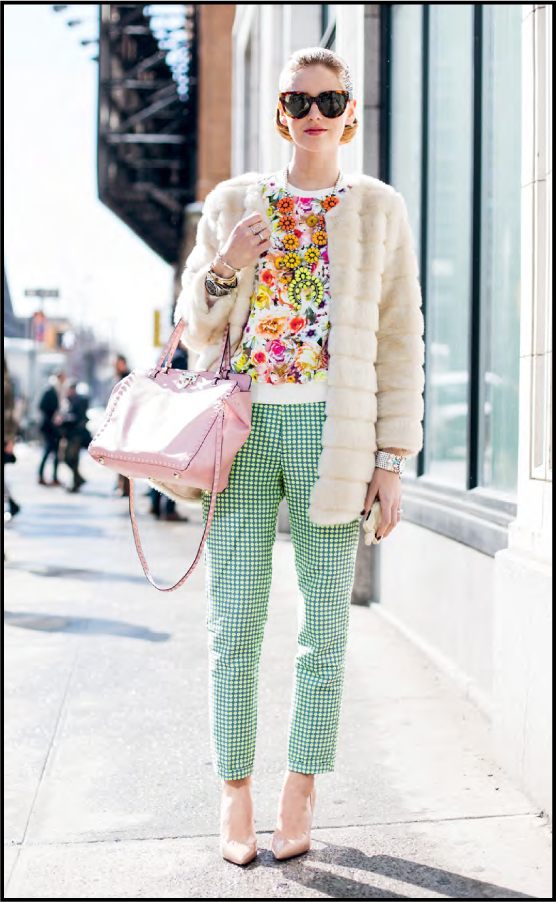
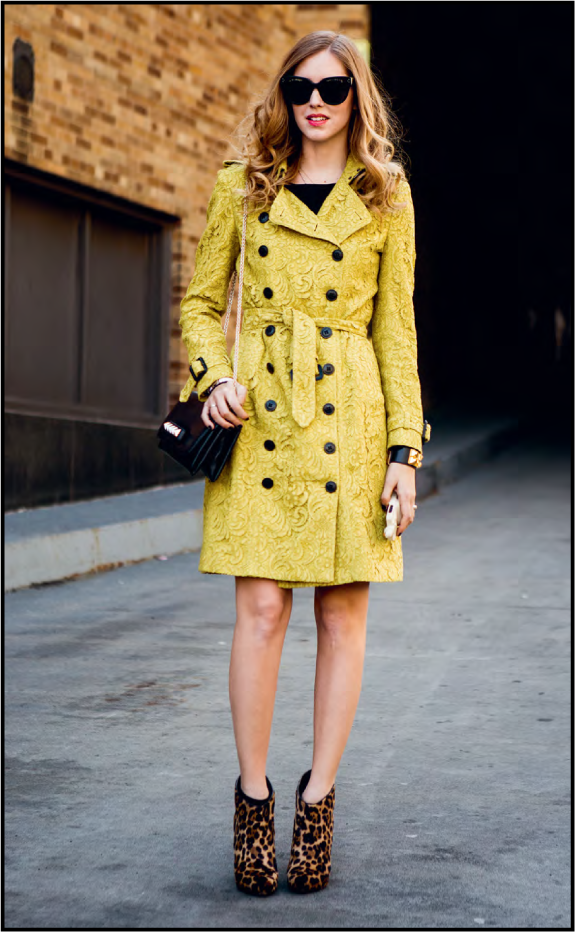
Providing customers with exclusive information is also the principle behind the Pursuitist website. It was launched by Christopher Parr, a veteran with 15 years experience in luxury digital marketing. “There is a shortage of online destinations for affluent consumers seeking authentic experience,” says Parr. “Plenty of cold bling sites exist, focusing on editorial content with ultra premium and inaccessible luxuries. That’s the void, and why Pursuitist was created.” Followers of the website get inside access to information in various sections, from epicurean pursuits to technology, from green issues to travel. Stories and editorials are created for these sections. Pursuitist is selective in the brands it works with. The brands, in return, reuse the content of the website on their own online channels (for example, through retweets). It is textbook cross-marketing with the consumer in the middle between brand and facilitator. The consumer is never made to feel like they are being pitched.

“Algorithms increase the probability of making a sale.”
An interview with Milton Pedraza, CEO of The Luxury Institute, a marketing consultancy in New York City.
How important is digital communication for luxury marketing today?
It’s absolutely critical. Digital communication enables sales teams to develop long-term relationships with people both in the store and beyond. Sales teams can reach out to customers using their digital devices and the information from the customer relations systems to contact customers, send “thank-you notes”, follow up activities after the first purchase or send individualised emails. The key point is that this enables sales teams to become radically more efficient and productive in building long-lasting relationships, which applies to both local as well as visiting customers. However, I don’t think that the brain will ever be replaced in the luxury world. The knowledge and the empathy of one human being being able to influence another, in this case the customer, will remain essential. Also for maintaining brand loyalty. That’s the critical need for digital communication today. Not just in marketing, but also in long-term, profitable relationship-building.
Digital and physical retail are not mutually exclusive, but can benefit from each other?
Yes. This particularly applies to the top 20 per cent of luxury brand customers, who tend to generate around 80 per cent of profits for the brands. The relationship between brand and customer can now be cultivated in a much more effective and efficient way.
Why has the luxury industry been so slow in adopting digital communication?
I think the luxury industry is paradoxical. On the one hand, it is the one industry that has brands spanning across hundreds of years, exhibiting resilience and longevity. On the other hand, the industry is slow to adapt to innovation. While this can be frustrating, I see wisdom in the practice of following certain innovations rather than leading them. In the areas of design, product and store innovation, for example, the luxury industry often takes the lead. But in the area of technology, the industry tends to take a slow, deliberative approach. Yet I don’t think it is fair to argue that this has been disadvantageous for the industry. While opportunities may have been missed in terms of timing, the industry eventually has caught up. There is no question that the luxury industry today is selling a considerable amount via e-commerce. However, the relationship-building mindset and execution has to be developed further, to move from a product culture to a customer culture.
What are good examples of luxury brands embracing digital communications?
Bottega Veneta is one of the brands that is doing fabulous things behind the scenes, in terms of relationship-building from the human side. I also think that Burberry is at the forefront in terms of leveraging technology, particularly within the store. But in the case of those companies, a great product obviously is the sine qua non.
Is Gucci’s smartphone app that allows you to purchase products a good model for luxury e-commerce? E-commerce has traditionally been met with considerable scepticism.
To me, these kinds of apps are probably the least interesting aspect of technological innovation, because customers will be reluctant to install and use multiple apps for their favourite brands, on top of the range of apps they already use in their daily lives. Mobile websites are of course important, but unless these apps offer a highly individualised and relevant experience, the incentives may not be strong enough for consumers to download and actually use yet another app for an individual brand. Especially wealthy consumers want a personal and visually stimulating experience, which smartphone apps cannot provide.
But e-commerce in luxury is certainly growing.
Absolutely. However, it is the kind of e-commerce that has a strong human component, where experts are able to provide a comprehensive service and engage in dialogue in order to enhance the online experience. This will be the modus operandi of the future.
Do you think this will materialise differently in different places?
There may be slight geographical differences, but Chinese customers in Shanghai or in New York will want the same shopping experience. We are talking about well-travelled, global, in-the-know people, who have certain expectations of luxury brands which are universal in their nature: a great product, an entertaining and logical store as well as engaging, likeable, expert and trustworthy salespeople. Those elements, which we sometimes mistake as culture, have to be delivered regardless of any geographical or logistical circumstances in order to guarantee long-term success.
So there is a future for bricks-and-mortar retail?
Yes, although I do see certain changes. There is no doubt that technology has a considerable impact on certain facets of the industry, such as inventory management. However, there are crucial elements of the customer experience that cannot be replaced by machines. Algorithms will give you a certain lift, increasing the probability of making a sale, but they ultimately only serve to empower or enhance the human being. The Amazon model is an appealing one, but it does not have a human face and therefore does not apply to luxury brands.
Having knowledge of your customer is very important to the luxury industry. But are companies in a position to really be able to use all this data?
Yes, they are moving in this direction, and most brands are installing customer relations management systems. But the quality of the data, and which data you are able to obtain, matters. The data has to be collected intelligently but also in a respectful manner. Crucially, it must involve the consent and the trust of the customer. It also matters how the data is used. If any industry is able to benefit from big data, it will be the luxury brands, because they are relationship-builders.
Let’s talk about communication. Luxury has always been about the promise of mystery and exclusivity and much of that has disappeared with the Internet. Is this a positive or negative development for the luxury industry?
It’s a great thing. Transparency can only be beneficial. Above all, the creative talents within the industry will have more tools to be creative. The feedback they absorb will enhance their output. Secondly, the real-time dimension will improve the customer’s experience. Because these companies, for the most part, are ethical and passionate, this increase in transparency can only be favourable to them. When you are unique, transparency and rapid communication helps you to get your message across. At the same time, it makes you more vulnerable, as mistakes are immediately amplified to the world.
Speaking of transparency: Do luxury brands need to be more sustainable?
Sustainability is a far greater imperative for luxury brands because, for the most part, they are not necessities. Customers tend to have a higher tolerance for unethical companies or products when those fulfil some basic and indispensable needs. Luxury brands need to be impeccable in many ways. They must be ethical and treat their stakeholders well. And they should be environmentally and socially responsible, and give back to those in need.
Mass-market retailer H&M advertises aggressively that it is using organic cotton. Prada does not. Is sustainability not a selling-point for luxury products?
H&M may use organic cotton, but it also produces its textiles in some of the places in the world with the worst working conditions. While luxury brands are also not perfect, they are unlikely to employ that type of production, and instead try to focus on having people who produce great products and giving them good conditions to work in. Compared to most other industries, the luxury industry is aware of the need for social responsibility, and can probably be considered a leader in this field. Its executives, for the most part, are ethical, well-intentioned people. But it also has to be noted that consumers more often than not are reluctant to pay a premium for socially responsible products.
![]()
When you are unique, transparency and rapid communication help you to get your message across.
![]()
What’s your view about old and new gatekeepers? What role do magazine editors play vis-à-vis fashion bloggers?
Again, the only way to deal with this change is with honesty and authenticity. While you have the right to try to influence, fake reviews or fake editorials will ultimately have a harmful effect. Credibility and transparency on both sides must be mantras. Whatever a brand represents and stands for will be amplified across the blogosphere. This is true both when a luxury brand produces a great product, with great design, craftsmanship and quality, as well as when it makes a mistake and tries to cover it up. You cannot run and you cannot hide, and this is a good thing. Transparency is a kind of disinfectant for all industries. Ultimately, this apparent vulnerability will have a positive effect.
If you could allocate the marketing budget of a luxury brand, would you reduce efforts in glossy advertising and do more honest storytelling?
I would not necessarily reduce efforts in advertising, but strive to improve it. Awareness matters. One idea would be to use real but attractive people instead of skinny models. Another idea would be to better leverage the editorial content. It is also crucial to improve direct communication with customers, developing personal and relevant relationships with the top 20 per cent of your clients. Intelligent advertising should also be aimed at winning over new clients. The experience of the store, located in prime locations, remains a considerable driver for marketing.
